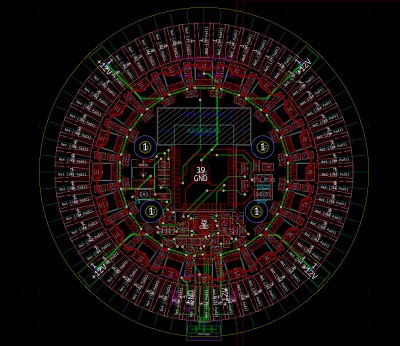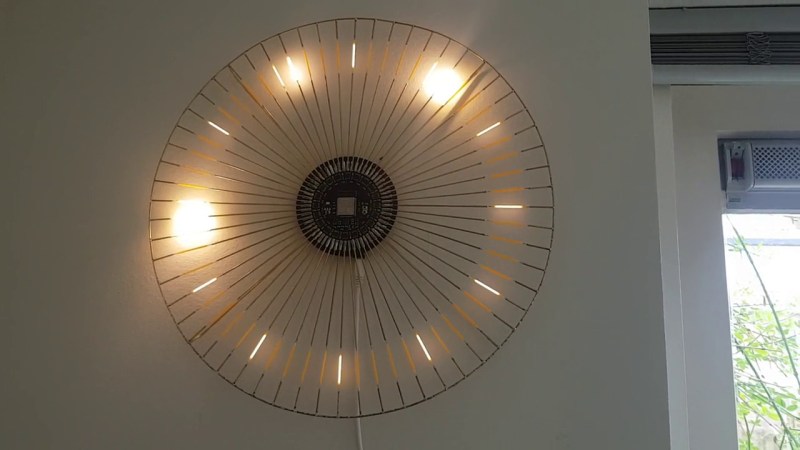LEDs have become so ubiquitous in our projects that just hearing that term probably conjures images of tiny illuminated domes in an array of single-spectrum colors. It’s easy to forget that these efficient sources of light come in a variety of form factors, including the retro-tacular filaments that [bitborked] used to make his beautiful analog LED wall clock.
Aside from its aesthetics, this timepiece features some great design. A custom PCB acts as a hub for all the LED filament spokes. The onboard brains come in the form of an ESP32, which means it can keep extremely accurate time via NTP.  WS2811 LED controllers, which we’re so accustomed to seeing alongside RGB LEDs that they almost feel strange to see here, provide the 12 volts required for each filament and make individual addressing a breeze.
WS2811 LED controllers, which we’re so accustomed to seeing alongside RGB LEDs that they almost feel strange to see here, provide the 12 volts required for each filament and make individual addressing a breeze.
[bitborked] takes advantage of that addressability to display other animations in addition to the standard clock face. They also plan to implement MQTT for eventual alerts from other home automation devices. When it comes to just telling time, you can discern the individual “hands” by differences in their brightness, which sadly does not show up as well in video as it does in real life.
We would certainly be happy to have this clock on our walls, and we hope to eventually see more of its PCB designs. In the meantime, though, we can drool over a more digital take on the LED filament clock. Although, filaments are certainly not required to make a beautiful LED timekeeper.















Sweet, and it has a very 50’s aesthetic. Does he share the PCB?
Sorry not atm, I made some mistakes in the design so the current one needed some bodges to get it to work.
I wanted to follow up on this and see if you are willing to share the PCB.
Thanks, not sharing atm as the current design has some errors that required bodges to make it work.
We’ll all be looking forward to V2.
That’s really nice. And sellable. Salable? Something like that.
Just when you think you couldn’t possibly be amazed by yet another clock build…<3
Imaginative use of those LEDs and great execution on the project.
Possible v2 improvements – I wonder if longer ones could be sourced, or multiple segments so the “hand” could be longer than the minute tickers. These segments are quite low current, I suspect you could use enamel wire to keep the lines clean.
Also maybe 3 TLC5947 (or 6 to do 2 segments per line) to drive the LEDs? It seems easier to package at least.
Thanks!
I looked for longer filaments but could not find any 12V ones. Multiples could be done I guess but you would see the gap between them and yes the current is low.
Oooooh I absolute love this design! That’s beautiful!
Similar to luminousobjects.com
Cool project! I’m using the WS2811 to control some high-power (“9W”) LEDs in a project I’m working on, although they’re just driving AL8860 switching LED drivers that can actually handle the 700mA current.
The WS2811 has open-drain, constant-current outputs, so rather than providing 12V, the 12V is run through the LEDs into the WS2811, which switches them on and off to maintain constant 18.5mA current.
hahah when i see those filaments naked like that i can’t help but think that they’ll oxidize from the enormous heat they generate and crack into pieces in a couple minutes. even though i have those bulbs all over my house for 5 years now, i still intuitively expect them to act like regular resistive-heating lights.